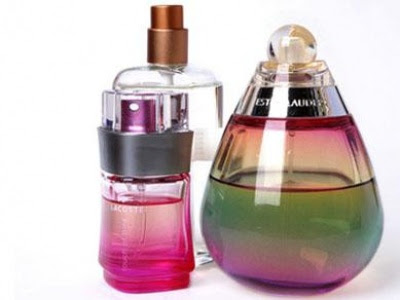 Many a perfume lover will tell you that layering perfumes is an insult
to the perfumers and a good way to ruin a piece of art that is already
complete unto itself – like listening to Mozart’s Requiem and the
Well-Tempered Clavier at the same time.
Many a perfume lover will tell you that layering perfumes is an insult
to the perfumers and a good way to ruin a piece of art that is already
complete unto itself – like listening to Mozart’s Requiem and the
Well-Tempered Clavier at the same time.Others will say, lighten up. Even Jean-Claude Ellena, a master perfumer himself, advocates layering perfumes to create certain effects and highlight a material or facet of one or both compositions. You can find some of Ellena’s suggested combos, as featured in French Elle, on Bois de Jasmin. Some of them are tame – adding Pleasures to Diorissimo seems harmless, one being a super-clean musky-aldehydic floral, the latter a textbook lily of the valley. Together, they’d conjure images of an ur-mother doing ur-laundry. Others are downright shocking – only a true misanthrope would attempt layering Angel, the original patchouli gourmand, with the ‘90s aquatic L’Eau d’Issey. They are completely different and both loud as a vacuum cleaner.
As long as a little care is exercised (new combinations should be test-driven in the privacy of your own home), I find layering to be fun and rather creative – along the lines of modifying published recipes to your own tastes, or at least going crazy with your pizza toppings. It’s also a good way to get more use out perfumes that are a little boring on their own or otherwise unsatisfactory – add something you like and give it new life.
If you’re looking for some layering guidelines, here’s what I’d suggest:

Start with one complex perfume and one simple one: Ellena gives himself no such restriction, but I think you’ll encounter fewer layering disasters if you stick to this rule. Simple perfumes are those that give the impression of one or two single, recognizable accords. For example, Bulgari Black smells primarily of vanilla and rubber. Soliflores, as the name suggests, smell primarily of a single flower, however many materials they may actually contain; see Frederic Malle’s Une Rose. Chanel No. 5 is more complex and abstract, with citrus and aldehydes up top, a handful of floral heart notes and an ambery base.
Look for at least one note or accord in common: You can use one perfume to enhance an aspect of another, making it sweeter or more rosy, for example. Perfumes that share a common link, such as lavender or leather, are often reasonable candidates for layering. As a bonus, adding more complexity can help cover up any aspects of a perfume that you don’t care for.
If the prospect still frightens you, remember these three things. One, you can try out new combos on paper before you wear them. Spray the perfumes on separate smelling strips (you can make your own using heavy paper), then smell the strips together. Two, if you try a combo on skin and it turns your stomach, you can always wash them off. (I find rubbing alcohol, followed by a soap-and-water wash, to be more effective than soap alone.) Three, your nose can only perceive so much at once. Most of the time, one of the two perfumes you layer will stand out as more prominent to your nose, the second simply adding a little extra interest. You generally won’t smell every element of both perfumes at once.











0 comments:
Post a Comment